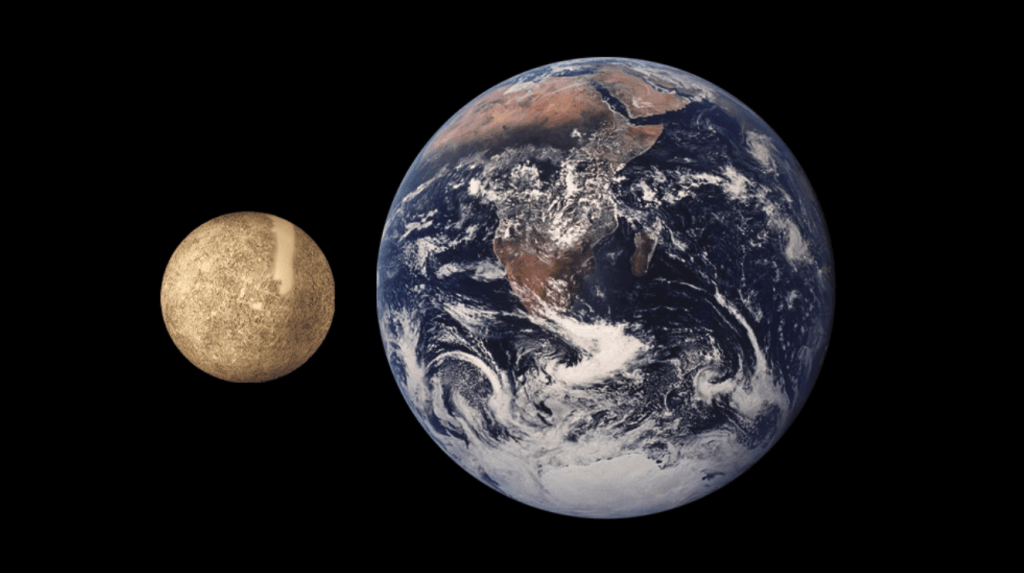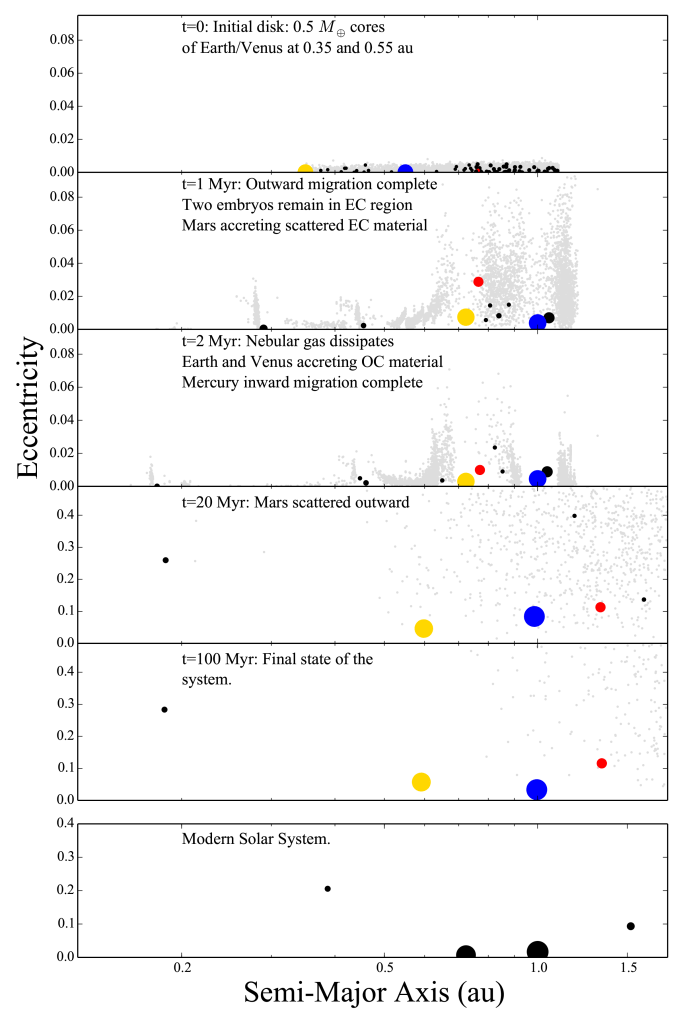
Scientists have long wondered why Mercury (left) is so much smaller than Earth. The tiny planet is little more than the Earth’s iron core without its thick silicate mantle layer. Image from NASA.
Outward movement of Venus and Earth may have swept up lighter elements,
making Mercury small and iron-rich
The discovery of a vast population of exoplanets orbiting other stars transformed scientists’ understanding of how planets form. In particular, planets forming and then moving closer to or farther from their stars seems to be common. A team led from the Carnegie Institution for Science in Washington, DC, successfully used PSC’s Bridges and Bridges-2 systems to test the idea that such outward movement of Venus and the Earth could explain the mystery of why the planet Mercury is as small and iron-rich as it is.
WHY IT’S IMPORTANT
Prior to the 1990s, planetary scientists thought they had the Solar System figured out.
Except for Mercury.
Early computer simulations of planet formation successfully recreated the locations of the four inner, “terrestrial” planets — Mercury, Venus, Earth and Mars. But in the simulations Mercury and Mars wound up about the same size as Earth and Venus. The real Mercury is only five percent the mass of Earth; Mars, 11 percent. Mercury’s composition was also way off. Earth and Venus have iron cores, with outer shells containing lighter elements like silicon. Mercury, by contrast, is mostly just a ball of iron.

“By the ’80s and ’90s, we were able to calculate this problem and replicate the four terrestrial planets with a high degree of frequency at the right locations … and the right time, so we thought we had the right picture … But the outstanding issue … was that it’s very challenging to replicate the masses of the four terrestrial planets.”
— Matt Clement, Carnegie Institution for Sciences
Then came the explosion of exoplanet discoveries of the 1990s and 2000s. In particular, rather than discovering terrestrial planets like the ones in our solar system, astronomers found a population of Jupiter-like gas giant planets that orbit their stars at ridiculously small distances. Everything the scientists knew said that gas giants never could have formed that close to the heat of their stars.
They must have moved.
Matt Clement of the Carnegie Institution and colleagues there and at the Laboratoire d’Astrophysique de Bordeaux in France decided to test an alternative idea for Mercury’s formation. They wanted to find out whether Venus and Earth may have formed much closer to the Sun, and moved outward to their current positions, in the process disrupting Mercury’s formation. To simulate the vast number of small particles that came together to form the planets in the early Solar System, they turned to the graphics-processing-unit (GPU)-rich power of PSC’s Bridges and Bridges-2 advanced research computers.
HOW PSC HELPED
Planets form from a disk of dust that accompanies the birth of a star. First the dust particles collide and stick to each other. As the particles that result from dust grains merging grow, their gravity becomes strong enough to attract more dust and particles. Through this much more rapid process of direct gravitational collapse, the particles become small asteroids. These in turn collide and become mini-planets called planet embryos, which then collide to form the planets.
To test fully the idea of Venus and Earth forming closer to the Sun, the team would have to simulate a vast number of particles. They’d also have to carry out dozens of simulations, so that they could see the many possible paths that the random collisions could follow. By doing a lot of repetitions, they’d be able to test how often each given result occurs and how varied the final outcome might be.

By simulating the infant Venus and Earth forming much closer to the Sun than their present orbits (starting at the top), the scientists were able to recreate a scenario in which the two planets over 100 million years swept the inner Solar System clean, robbing Mercury of lighter elements as it formed and making it much smaller, recreating something close to the real Solar System (moving toward the bottom). From Clement MS, Raymond SN, Chambers JE (2021) Mercury as the relic of Earth and Venus outward migration. The Astrophysical Journal Letters, 923:L16. https://doi.org/10.3847/2041-8213/ac3e6d.
Carrying out many large, computer-memory hungry tasks in parallel is a particular strength of GPUs. Developed to create better images for computer games, GPUs turned out to have unexpected strengths in research computing as well. Parallel computation is one of them. But the planetary simulation problem was so large that the usual GPUs available to researchers still wouldn’t be fast enough to get the simulations done in a reasonable amount of time.
“You need to be able to leverage [a] number of GPUs at a time to get this project done in a reasonable amount of time … Just having access to those next-generation [V100] GPUs [was necessary] … On those legacy K20 and K80s, you just cannot do this threshold formation problem, it is just too much of a bottleneck.” — Matt Clement, Carnegie Institution for Sciences
The team had started their planetary formation simulations on PSC’s National Science Foundation-funded Bridges system; for the Mercury work, they transitioned to the more powerful Bridges-2. The latter, upgraded computer’s 192 NVIDIA Tesla V100 GPUs gave the Carnegie team the ability to use as many as 24 cutting-edge GPUs at once. The scientists’ work would use the GPUs for the otherwise slow, painstaking task of simulating the details of particles interacting with each other. Then the computations would switch to Bridges-2’s tens of thousands of central processing unit (CPU) cores to work out the more math-intensive but less parallel orbital calculations.
Their simulations supported the hunch that movement was the key to Mercury’s formation. In the sims, Venus and Earth formed much closer to the Sun — between a tenth and a half of the distance that Earth is now — and moved outward, winding up exactly as they had in the earlier simulations. Earth wound up with the same composition it has in real life. Venus had an almost identical composition, a prediction that future Venus space missions will be able to test. Mars, too, had an interesting path, forming first in the region of Venus and Earth’s modern orbits and then being flung out to its current orbit. In the process it collected some but not as many light elements as the other two, making it smaller than it would have been.
The real payoff was with Mercury. In the simulations, the two Earth-like planets’ gravity vacuumed up the lighter elements from the dust disk as they migrated outward. There were almost none of these elements left for Mercury, and so that planet formed what was essentially only the iron-rich core of an Earth-like planet with only a small outer layer of silicate rock mantle. While Mercury’s composition proved to be variable — some of the sims produced a planet like Mercury and others didn’t — the work at least showed that Mercury’s formation as it is today was possible, even likely. The team published their work in The Astrophysical Journal Letters in December 2021.
For future work, the scientists need new space missions to sample material from Mercury, Venus and Mars to test how accurately the simulations are predicting each planet’s composition.
